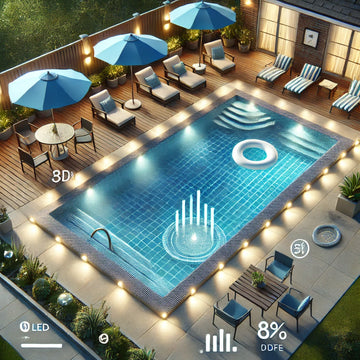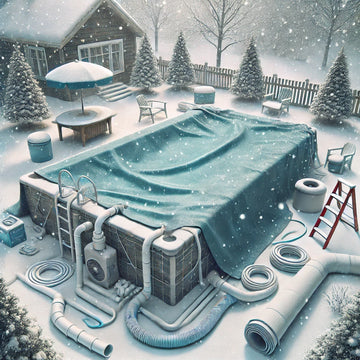INDUSTRY TIPS ON HOW TO SUCCESSFULLY OPEN YOUR POOL THIS SEASON
Pool opening season has arrived! Despite the recent surge of cool, rainy weather, it’s time to start thinking about your pool and what you need to do to start using it – this means putting in a little extra effort into your pool if you want it in pristine condition this summer.
If you’re like many pool owners, you may not have enough time to spend on this intricate process, or you may not know precisely how to open a pool. Additionally, if you need a swimming pool restoration, you’re looking at a delayed swimming season, unless you contact the pros right away.
We’ve put together a list of industry tips on how to have a successful pool opening so you can maximize your enjoyment this summer.
WHAT CHEMICALS ARE NEEDED?
You will need to use pool chemicals to clean and balance your pool water. Balanced water keeps your pool clean, safe, and protects your pool from damage.
*Tip: Make sure the pump stays running for at least 24 hours to circulate the chemicals to ensure every inch of your pool is treated.
CLEANING CHEMICALS
The following chemicals are necessary to help treat and clean your pool:
- Stain and scale preventer—this chemical should be added first, poured slowly around the perimeter of the pool;
- Clarifiers (as needed);
- Chlorine tablets; and,
- Algaecide—this should be added last, a day after balancing the pool water (specifically for high algae water issues).
WATER-BALANCING CHEMICALS
To find out which chemicals you’ll need to balance the pool water, test the water with strips or a water testing kit. You will need to keep testing and, if necessary, balancing the water once a week throughout the pool season.
Keep in mind that last year’s testing materials may not be as accurate this year. It’s a good idea to replace these annually for optimal test results.
Write down the test readings and use them as a guide when adding chemicals. For balanced pool water, you will want to aim for these targets:
THE IDEAL POOL CHEMICAL TARGETS
- pH: 7.2 – 7.6
- Total Alkalinity: 80 – 120 ppm
- Calcium Hardness: 150 – 225 ppm
- Cyanuric Acid: 30 – 50 ppm
- Free Chlorine: 1.0 – 3.0 ppm
To reach these target chemical ranges, you can raise or lower the levels with the following pool chemicals:
ALKALINITY INCREASER
Start with adjusting Total Alkalinity (TA) since it will affect pH levels. Add Alkalinity Increaser if the TA level is below 80 ppm. If it’s above 120 ppm, add pH Decreaser to bring down the level to within the ideal range of 80 – 120 ppm.
PH INCREASER & DECREASER
If your pool water’s pH level is below 7.0, it will become acidic and corrosive. To treat this, use pH Increaser to bring the pH up to at least 7.2.
When the pH is above 8.0, the water will become basic, chlorine will be slow to react, and your pool will be at risk of cloudy water and scale deposits. Here you should use pH Decreaser to bring the pH down to the ideal range of 7.2 – 7.6.
CALCIUM HARDNESS INCREASER
The ideal range of Calcium Hardness is 150 – 225 ppm. However, this number is flexible since many people have hard tap water in the 400 – 600 ppm range. To be safe, you don’t want this level to go any higher than 400 ppm.
Soft water (when Calcium Hardness is below 150 ppm) can become corrosive, causing etched or dissolving concrete, corroded metal, staining, and deposits. Adding a Calcium Hardness Increaser will raise the level to avoid these issues from occurring.
If your water’s Calcium Hardness is too high, your pool water can become cloudy, and calcium sediments can build up on the pool walls and in the plumbing. To avoid this, you can do one of the following:
- Replace the pool water with softer water to lower the Calcium Hardness;
- Use a water flocculant product to attract excess calcium so it clumps together. Then clean the pool walls, floors, backwash, and pump filter; or,
- Add muriatic acid to bring the water back to balance.
CYANURIC ACID (STABILIZER)
There is usually zero Cyanuric Acid in a freshly filled pool. To boost this level up, add 3lbs of Stabilizer per 10,000 gallons of pool water. This will help protect the Free Chlorine from evaporating in the sun.
GRANULAR CHLORINE (POOL SHOCK)
After you’ve balanced the other pool chemicals, you can raise the chlorine level with a pool shock. Pool shock with granular chlorine is a standard method to quickly increase the chlorine levels high enough to destroy contaminants, pathogens, and combined chlorine molecules.
HOW MUCH CHLORINE DOES IT TAKE TO SHOCK A POOL?
There are two types of chlorine shock products, granular and liquid. While the liquid chlorine can be added directly to the pool water, the granular chlorine must first be dissolved in lukewarm water before adding to the pool. This will ensure the granular chlorine circulates properly and won’t damage the pool walls or liner.
The amount of chlorine shock you will need will depend on the amount of water in your pool. Here are the guidelines to shock your pool effectively:
- 65g of granular chlorine per 10,000L of pool water;
- 1L of liquid chlorine per 10,000L of pool water.
After adding the chlorine to the pool, wait 10 minutes, and test the water again. If the chlorine is still below 1.0 ppm, repeat the shock. If your swimming pool is green or black, it’s advised to raise the chlorine level a bit higher between 5 to 10 ppm. It’s highly recommended to avoid swimming while bringing back a green or black pool.
SALTWATER – HOW MUCH SALT IS NEEDED TO OPEN A POOL?
For saltwater pools, add as much salt as needed to reach the recommended salinity level for your saltwater chlorinator. Ideal salinity typically ranges from 2700 to 4500 ppm.
HOW DO I DRAIN MY POOL?
If you want to drain your pool to give it a good cleaning, you can rent a submersible sump pump from your local hardware store. Make sure to start the draining early in the day so your pool will be empty before dark.
You’ll want to measure the distance from your pool to the clean out/sewer access point and make sure the sump pump rental comes with rubber fire hoses that will reach that distance (usually two 50-foot hoses will do).
- Connect the hose to the sump pump and place the other end into a clean out on your property—a plastic pipe with a screw cap. If this is connected to your home, speak with a pool specialist first to prevent damage.
- Lower the pump into the pool and plug it in.
- Watch the water disappear and make sure it discharges at a speed that meets your municipal by-law.
- After a foot of water has been emptied, spray the previous water line with a hose to help clean any stains.
HOW LONG DOES IT TAKE TO EMPTY A SWIMMING POOL?
The time it takes to empty a swimming pool will depend on the sump pump’s speed, the total size of the pool, and the municipality laws. For example, if you pump out a 25,000-gallon pool at 30 gallons/minute, it will take about 14 hours to empty your pool.
Since you will be pumping water directly into the municipal sewer system, you need to follow the laws set out by your municipality carefully.
NO TIME? CALL THE PROFESSIONALS TO GET IT DONE QUICK AND EASY
If you don’t have the free time to open your pool this season, contact the pool opening professionals. They can get this work done quickly for you so you can have an easy pool opening and enjoy your clean pool sooner than later.




